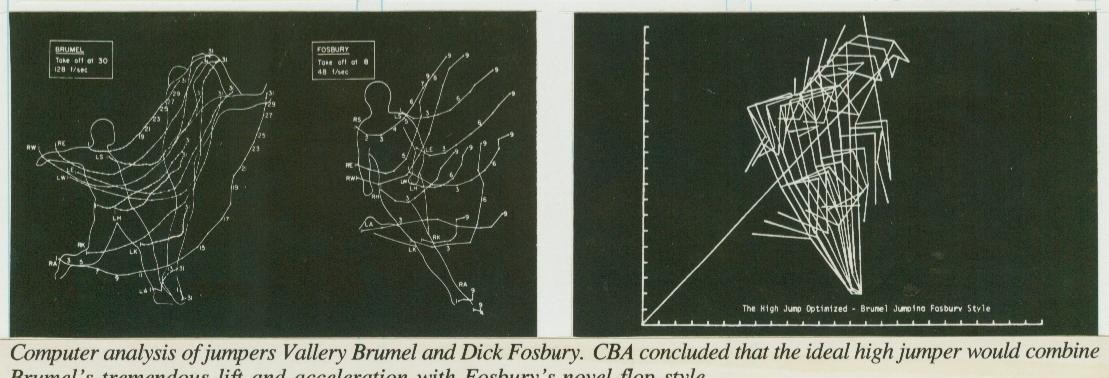| Previous | Index |
![]()
In the back room of CBA's unassuming headquarters is more than $300,000 worth of equipment, including computer programming devices and special tracing equipment, all hooked to a network of computers in different cities. CBA also has a special arrangement with the University of Massachusetts Computer Center.
Beyond the operations area is the trophy room, where an assortment of chrome body-building machines stand out, all designed or refined by (TA. Dr. Ariel points with pride to a machine he designed for Universal Gym. "With this piece of equipment, an athlete is able to strengthen his muscles by lifting an increasing amount of weight - up to 1,010 pounds."
Gideon Ariel is the bedrock on which the company is built. He is not only a pioneer in human motion analysis, but is also committed to sharpening and refining human physical potential. For him, his work is a cause.
Ariel sets the tone and tempo at CBA headquarters, and his Israeli background has much to do with the working climate. Everyone is fastidious, aware of their goals, achievement oriented, yet relaxed. Studying computer readouts at 2 A.M. is not uncommon for them.
Ariel can appreciate an athlete's struggle for perfection. He hurled the discus for Israel in the 1960 and 1964 Olympics, starred for the University of Wyoming track team, and was an assistant track coach at the University of Massachusetts. The U.S. Olympic Committee has used his services, and so has Mac Wilkens, the 1976 Olympic gold medal discus thrower. Seven
months before the Olympics, Ariel was observing Wilkens at a meet. And as a result of his biomechanical calculations, Wilkens was eventually able to throw the discus 16 feet further than his previous best.
Because of his dedication to amateur athletics, Ariel refuses to take money for analyzing a nonprofessional athlete's performance. Since receiving his Ph.D. in Exercise Science from the University of Massachusetts, he has developed an international reputation and has many friends in the sports world. Bill Toomey, the 1968 Olympic decathlon champion, is not only a friend but works for CBA as a market specialist, representing the company in the West.
Though involved in a flourishing business, Ariel remains a scholar. He is still involved in university research. Through a National Institute of Health grant, he and University of Massachusetts professor Michael Arbib are measuring cat coordination, trying to find out how the animal's brain controls its muscles. "Perhaps from this study," he says, "we might discover a clue as to how to improve human coordination." Some of the research work is taking place at CBA.
Graduate work in exercise science drew CBA President Ann Penny to Amherst. She expects to have her University of Massachusetts doctorate in June.
"Ann is steady; she knows every facet of our business," says Dr. Ariel. "Perhaps that's why the stockholders elected her president."
Determination and dedication best describe the North Carolinian, who admits to being swept up by Ariel's enthusiasm. "Biomechanics
is an exciting field," she says. "And it's thrilling to be in the forefront of a science that can do so much good for people; not only athletes, but for the average person as well.
"Unfortunately very little thought is given to designing things like shoes that are biomechanically sound. More effort and money are devoted to the cosmetic aspect than to consideration of the bodily damage poorly designed shoes can generate. Back problems can result from bad footwear.
Penny has another deep concern. "Coaches seem threatened by what we can do for their athletes. They think we'll put them (the coaches) out of business, but the opposite is true. We can help them optimize their athlete's performance.
"Take the time we analyzed Bill Schmidt, the javelin thrower. The computer data showed that he lost force because he dropped his hip when executing. After pointing that out to Schmidt, he uncorked a throw of more than 300 feet, a record for him.
"We can help Los Angeles Rams kicker Tom Dempsey regain the form he had when he was booting longer field goals. Remember when he was with the Saints, and he kicked a 63-yarder? We analyzed pictures of that kick and discovered that he had more arm swing then than he has now. The coaches made Dempsey shorten his arm swing; consequently, shorter kicks."
A graduate of the University of North Carolina at Greensboro, Penny coached basketball and tennis at Princeton day school in New Jersey. She practices what she preaches and jogs 10 miles daily.
THE NEW ENGLANDER May 1977

![]()
| Previous | Index |